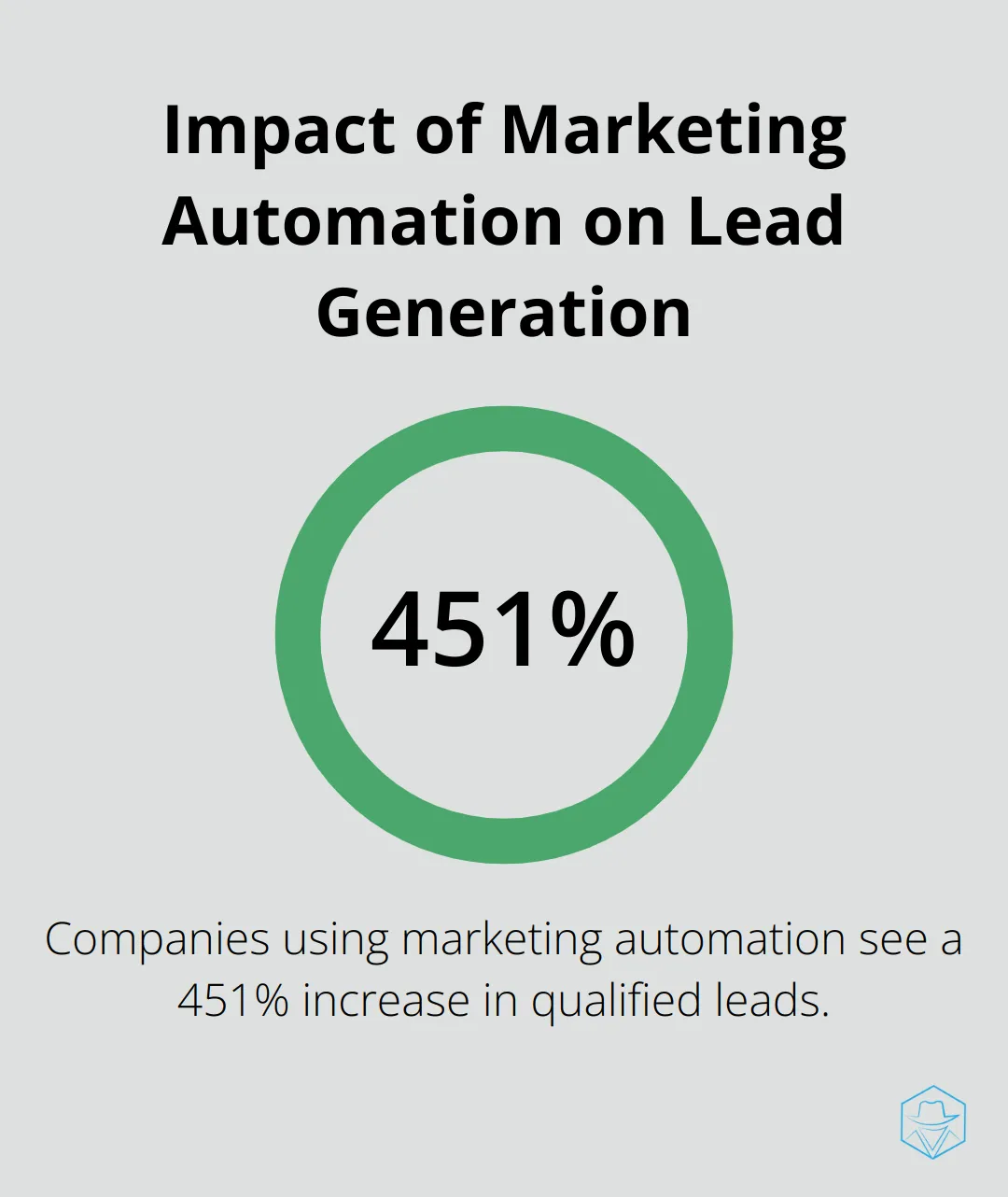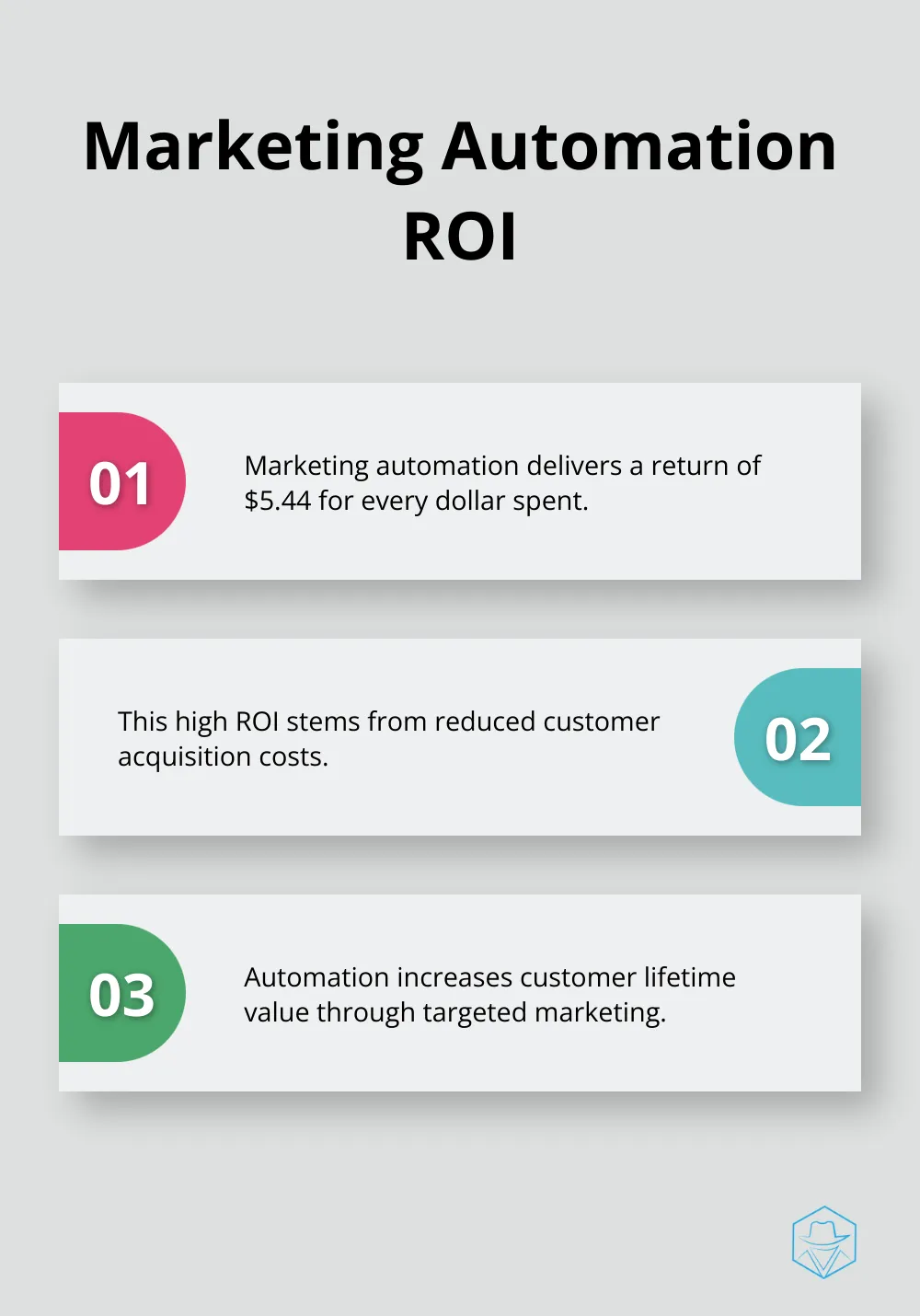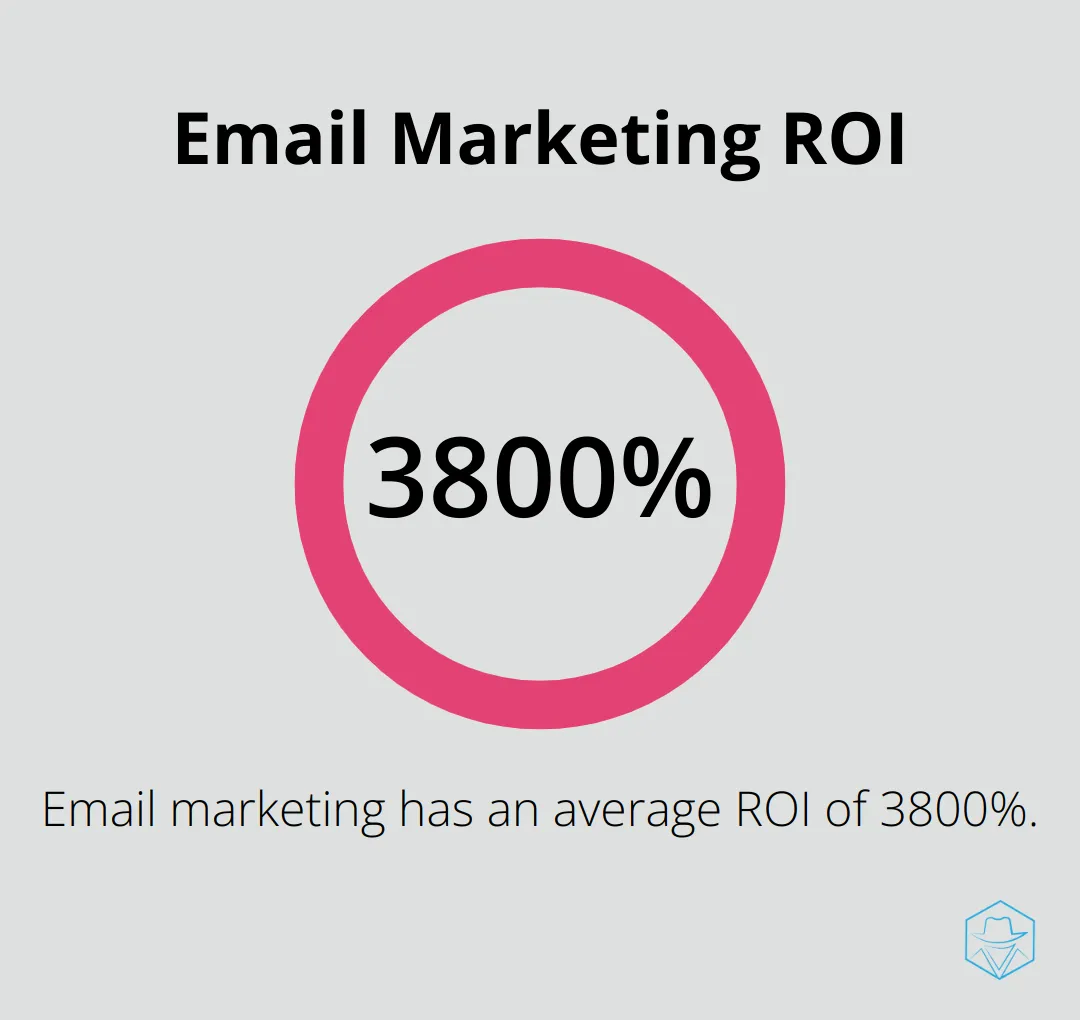Measuring the ROI of Marketing Automation

Marketing automation has revolutionized how businesses approach their marketing strategies. However, measuring its effectiveness can be challenging.
At Drop Cowboy, we understand the importance of quantifying the ROI of marketing automation to justify investments and optimize campaigns.
This blog post will explore key metrics, calculation methods, and strategies to overcome common challenges in measuring marketing automation ROI.
How to Measure Marketing Automation ROI
At Drop Cowby, we know that measuring the return on investment (ROI) of marketing automation is essential for optimizing your campaigns and justifying your marketing spend. Let’s explore the key metrics you should track to evaluate the effectiveness of your marketing automation efforts.
Lead Generation and Conversion Rates
The first step in measuring marketing automation ROI involves tracking your lead generation and conversion rates. These metrics show how well your automated campaigns attract potential customers and move them through the sales funnel.
To calculate your lead generation rate, divide the number of new leads by the total number of visitors to your website or landing pages. For conversion rates, examine the percentage of leads that take a desired action (such as making a purchase or signing up for a demo).
A study by Marketo found that companies using marketing automation see a 451% increase in qualified leads. This statistic highlights the potential impact of well-implemented automation strategies on lead generation.

Customer Acquisition Cost and Lifetime Value
Two critical metrics for assessing marketing automation ROI are Customer Acquisition Cost (CAC) and Customer Lifetime Value (CLV). CAC represents the total cost of acquiring a new customer, including marketing and sales expenses. CLV estimates the total revenue a customer will generate over their entire relationship with your business.
To calculate CAC, divide your total marketing and sales costs by the number of new customers acquired in a given period. For CLV, multiply the average purchase value by the average purchase frequency and the average customer lifespan.
A study by Nucleus Research discovered that marketing automation delivers a return of $5.44 for every dollar spent. This impressive ROI often stems from automation’s ability to reduce CAC and increase CLV through more targeted and efficient marketing efforts.

Qualifying and Scoring Leads
Marketing Qualified Leads (MQLs) and Sales Qualified Leads (SQLs) are essential metrics for evaluating the quality of leads generated through your marketing automation efforts. MQLs are leads that have shown interest in your product or service but aren’t ready to buy, while SQLs are leads that are deemed ready for direct sales outreach.
Implementing a lead scoring system within your marketing automation platform can help you identify and prioritize high-quality leads. This approach allows you to focus your resources on the most promising prospects, ultimately improving your conversion rates and ROI.
A report by Gartner reveals that companies that automate lead management see a 10% or greater increase in revenue within 6-9 months. This statistic underscores the importance of effective lead qualification and scoring in driving marketing automation ROI.
Continuous Improvement and Optimization
To maximize the ROI of your marketing automation efforts, you must continuously monitor and optimize your campaigns. Try to implement A/B testing for your email subject lines, landing page designs, and call-to-action buttons. This approach will help you identify the most effective elements of your campaigns and refine your strategies over time.
Additionally, use the data collected from your marketing automation platform to segment your audience and create more targeted, personalized campaigns. Personalization can lead to higher engagement rates and, ultimately, better ROI.
As we move forward, let’s explore how to calculate ROI for different marketing automation strategies, including email marketing campaigns, social media automation, and lead nurturing programs.
How to Calculate ROI for Key Marketing Automation Strategies
Email Marketing Campaigns
Email marketing stands out as one of the most effective channels for automation. To calculate its ROI, track key metrics such as open rates, click-through rates, and conversion rates. Use this formula:
(Revenue generated from email campaigns – Cost of email campaigns) / Cost of email campaigns = Email Marketing ROI
For instance, if your email campaigns generated $50,000 in revenue and cost $10,000 to run, your ROI would be 400% ((50,000 – 10,000) / 10,000 = 4, or 400%).
A study by the Data & Marketing Association revealed that email marketing has an average ROI of 3800%. This high return makes it a prime candidate for automation efforts.

Social Media Automation
Measuring social media ROI presents challenges, but it’s achievable. Focus on engagement metrics (likes, shares, comments), click-through rates to your website, and conversions from social traffic. Apply this formula:
(Value of conversions from social media – Cost of social media campaigns) / Cost of social media campaigns = Social Media ROI
Factor in the time saved through automation when calculating costs. Tools that schedule posts and analyze performance can significantly reduce labor hours.
Lead Nurturing and Scoring
For lead nurturing campaigns, track the progression of leads through your sales funnel. Calculate the conversion rate of nurtured leads compared to non-nurtured leads. Here’s a simple formula:
(Revenue from nurtured leads – Cost of nurturing campaigns) / Cost of nurturing campaigns = Lead Nurturing ROI
Measure lead scoring ROI by comparing the close rates of leads with high scores to those with low scores. If your high-scoring leads close at a significantly higher rate, your scoring system likely provides a good return.
Personalized Content Delivery
Personalization can dramatically improve engagement and conversion rates. To calculate its ROI, compare the performance of personalized content against non-personalized content. Use this formula:
(Revenue from personalized campaigns – Cost of personalization) / Cost of personalization = Personalization ROI
A study by Epsilon found that personalized emails have an open rate 29% higher than non-personalized emails, highlighting the potential ROI of this strategy.
The true value of marketing automation often extends beyond direct revenue. Consider factors like improved customer satisfaction, increased brand awareness, and time savings when evaluating the full impact of your automation efforts. As we move forward, we’ll explore the challenges that businesses face when measuring marketing automation ROI and discuss strategies to overcome these obstacles.
Overcoming Challenges in ROI Measurement
Data Integration and Accuracy
Measuring marketing automation ROI often stumbles due to data silos. Many businesses use various tools for different marketing functions, which complicates holistic performance analysis. To solve this, companies should invest in a comprehensive marketing automation platform that integrates with CRM, analytics tools, and other marketing software. This integration enables seamless data flow and more precise ROI calculations. (Companies with strong sales and marketing alignment have achieved 20% annual revenue growth, according to HubSpot’s State of Marketing Report.)
Attribution Modeling
Determining which touchpoints in the customer journey contribute most to a conversion presents a significant challenge, especially in complex B2B sales cycles. To address this, businesses should implement a multi-touch attribution model that credits all touchpoints in the customer journey. Various attribution models help understand the impact of different channels and campaigns. (A study by Bizible showed that companies using multi-touch attribution models experienced a 10% increase in revenue compared to those using single-touch models.)
Aligning Marketing and Sales Teams
Misalignment between marketing and sales teams can lead to inaccurate ROI measurements. When these departments operate in isolation, tracking leads from initial contact through to closed deals becomes challenging. To resolve this, companies should establish regular meetings between marketing and sales teams to align goals, metrics, and lead definitions. A shared dashboard showing lead progress through the funnel can also prove beneficial. (Aberdeen Group found that companies with strong sales and marketing alignment achieve a 20% annual growth rate, compared to a 4% decline in revenue for companies with poor alignment.)
Balancing Short-term and Long-term ROI
Many businesses struggle to balance immediate results with long-term value when measuring marketing automation ROI. This approach can overlook the cumulative benefits of automation over time. To address this, companies should set both short-term and long-term KPIs for their marketing automation efforts. Short-term metrics might include email open rates or click-through rates, while long-term metrics could focus on customer lifetime value or retention rates. (Forrester Research discovered that companies excelling at lead nurturing generate 50% more sales-ready leads at 33% lower cost, highlighting the importance of considering long-term ROI.)
Continuous Optimization
ROI measurement requires ongoing refinement and adaptation as businesses grow and evolve. Companies should regularly review and adjust their measurement strategies to ensure they capture the full value of their marketing automation efforts. This process involves analyzing performance data, identifying areas for improvement, and implementing changes to optimize ROI. (Regular optimization can lead to significant improvements in marketing automation performance and overall business results.)
Final Thoughts
Measuring the ROI of marketing automation empowers businesses to optimize strategies and justify investments. Key metrics such as lead generation rates, customer acquisition costs, and customer lifetime value provide valuable insights into automation effectiveness. Regular data analysis, campaign optimization, and alignment between marketing and sales teams ensure ongoing success in ROI measurement.
Advanced AI and machine learning algorithms will likely enhance predictive analytics for more accurate campaign performance forecasting. An increased focus on customer experience metrics will offer a more comprehensive view of automation’s impact beyond traditional financial indicators. These trends will shape the future of marketing automation ROI analysis and help businesses maintain a competitive edge.
At Drop Cowboy, we recognize the importance of demonstrating tangible results from marketing efforts. Our cutting-edge communication platform offers powerful tools for businesses to enhance their marketing strategies through ringless voicemail and SMS campaigns. With features like Mimic AI™ for voice cloning and Smart Delivery™ for efficient global message distribution, Drop Cowboy enables businesses to create personalized, engaging campaigns while tracking performance metrics for optimal ROI.
blog-dropcowboy-com
Related posts

March 22, 2025
Embedded iPaaS: Streamlining Integration Processes
Simplify integration with Embedded iPaaS. Explore how this approach can enhance efficiency, flexibility, and connectivity across systems.

March 21, 2025
Key Benefits of Marketing Automation Revealed
Explore key benefits of marketing automation for efficiency, increased ROI, and enhanced customer engagement. Transform your strategy with proven insights.

April 21, 2025
Marketing Automation vs CRM: What’s the Difference?
Discover the key differences between marketing automation vs CRM and learn how each tool can drive your business success efficiently.

April 5, 2025
Choosing the Right Marketing Automation Course
Find the best marketing automation course with practical tips for success. Boost your skills and stay ahead in the evolving digital landscape.

April 21, 2025
Integrating Marketing Automation with Salesforce
Integrate marketing automation with Salesforce for streamlined processes, increased efficiency, and higher ROI. Learn practical tips and proven techniques.

March 21, 2025
How to Boost E-commerce Sales with SMS Marketing
Boost e-commerce sales effortlessly with SMS ecommerce strategies. Discover practical tips and proven methods to engage customers and increase revenue.